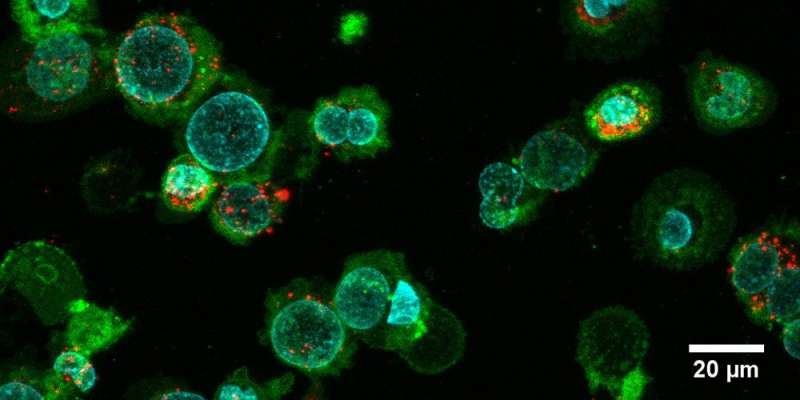
Particles known as extracellular vesicles play a vital role in communication between cells and in many cell functions. Released by cells into their environment, these “membrane particles” consist of a cellular membrane carrying a cargo of specific signaling molecules, proteins, nucleic acids and lipids. Unfortunately, only tiny quantities of the vesicles are formed spontaneously by cells.
The contents of these extracellular vesicles vary depending on the origin and condition of the cell, as do the proteins that are anchored to the vesicle surface. Researchers use these properties to develop new techniques for diagnosing cancer, for example, based on the analysis of extracellular vesicles isolated from blood samples.
Extracellular vesicles could also play a key role in the development of next-generation therapeutics. As the vesicles are of natural origin, they are biocompatible and can trigger a wide range of different reactions in the body.
Researchers therefore hope to use the particles to influence the immune system—for example, in order to destroy cancer cells. Until now, however, one major challenge has been the reproducible production of the large quantities of homogeneous vesicles needed for such studies.
A faster route to more particles
Now, a team of researchers led by Professor Jörg Huwyler from the Department of Pharmaceutical Sciences and the Swiss Nanoscience Institute (SNI) of the University of Basel has developed a highly efficient preparation method for extracellular vesicles that delivers up to 100 times more particles per cell and hour than conventional methods. They describe the new method in the journal Communications Biology.
“We start the preparation process by cultivating cancer cells, in which we induce cell death by adding chemical stressors,” explains Claudio Alter, first author of the study and a doctoral student at the SNI Ph.D. School. “The cells then form vesicles, which detach from the parent cell after a few hours.”
With a diameter of 1 to 3 micrometers, these giant plasma membrane vesicles are far too big for therapeutic applications. In the newly developed process, they are therefore pressed through a filter membrane multiple times in order to reduce their size. “After multiple filter passes, we obtain a homogeneous solution of nano plasma membrane vesicles (nPMV) with a diameter of 120 nanometers—precisely what we need for subsequent applications,” explains Alter.
Different origin, different applications
The team of researchers then characterized these nPMVs and compared their size, homogeneity, and protein and lipid cargo with those of exosomes—currently the most commonly used extracellular vesicles. They also investigated how well the nPMVs interact with other cells. In these analyses, the nano plasma membrane vesicles showed similar properties to exosomes.
“Their specific cargo and the presence of membrane-bound markers derived from the parent cell line offers the possibility to use nPMVs for therapeutic purposes,” says Jörg Huwyler. “At present, we’re primarily thinking of a stimulation of the immune system—for example, in vaccination or in immunotherapy treatments for cancer.”
More information:
Claudio L. Alter et al, High efficiency preparation of monodisperse plasma membrane derived extracellular vesicles for therapeutic applications, Communications Biology (2023). DOI: 10.1038/s42003-023-04859-2
Journal information:Communications Biology
Provided by
University of Basel

READ MORE
Smithsonian Scientists Are Using Algae to Revitalize America’s Waterways
The algal scrubber in action. Courtesy of Smithsonian Sidedoor Listen to this episode of Sidedoor, [...]
4 Ways to Save Money Around Your Home
Pretty much everyone would like to have a little more cash in their wallet. Maybe [...]
Will China’s Growing Appetite for Meat Undermine Its Efforts to Fight Climate Change?
A butcher in Meizhou, China Flickr user Taro Taylor At the center of the table [...]
A Quick Guide to Owning the Universe
What bits of the universe are legal to own? NASA If someone tries to sell [...]
How to Drain a Waterbed Without a Pump
Striped purple and pink bed iStockphoto.com/zveiger alexandre A waterbed is a bed whose mattress is [...]
Woolly Mammoths Roamed Far and Wide Just Like Living Elephants
An adult male woolly mammoth navigates a mountain pass 17,100 years ago. James Havens Woolly [...]
How Does Nature Carve Sandstone Pillars and Arches?
Delicate Arch in Arches National Park near Moab, Utah. Courtesy of Flickr user Dimitry.S. Some [...]
The Fascinating History of the Mimeograph Machine
The mimeograph worked by using a stencil to create copies of text or images. Douglas [...]